The best Panasonic camera can mean the famous mirrorless Lumix G cameras, which come in all shapes and sizes. A Lumix G camera might be a slim shooter for travel, or one of the best consumer video cameras ever made. It's a broad, exciting system – and it's far from all there is to talk about when it comes to Panasonic!
Lumix G cameras use Micro Four Thirds sensors. These are a little smaller than the APS-C sensors found in rival mirrorless cameras from the likes of Fujifilm, and while this may seem like a disadvantage, it does enable the system to field much smaller and lighter bodies and lenses, making it significantly more portable for travel.
Plus, these cameras have another ace in the hole. Panasonic has been aggressively upgrading its cameras over the years with some of the most interesting video features in any system, meaning these are some of the best photo/video hybrid cameras you can get in terms of versatility. Indeed, some of the Lumix G cameras like the GH series, are regarded as the best consumer video cameras you can buy.
(It's also worth noting that the open nature of the Micro Four Thirds system allows the best Micro Four Thirds lenses from Panasonic to be interchanged with the best Olympus lenses, making one of the most diverse lens ecosystems in the game.)
Lumix cameras also come as fixed-lens compacts. From long-zoom travel cameras to do-it-all bridge cameras and high-end compact cameras for enthusiasts, the Lumix G compact selection is well-stocked, and ideal for those who want a simpler image-making proposition, as opposed to the fuss and expense of swapping lenses.
Panasonic has also ventured successfully into the world of professional full-frame mirrorless cameras. Its Lumix S1 and Lumix S1R models, and the Lumix S1H cinema camera, have recently been joined by the Panasonic Lumix S5 II, which is arguably one of the best balances between features, performance, and price that we've ever seen, and is undoubtedly one of the best mirrorless cameras you can buy right now. In an alliance with Leica, these cameras use L-mount lenses, so you can also expect more inter-brand camera/lens compatibility in the future.
We've split our guide up along these lines – first, we've picked our favorite Lumix G mirrorless cameras, then the best Lumix S full-frame mirrorless cameras, and finally the best Lumix G compacts. You can skip straight to the section of your choice, or just scroll on as we count off the best Panasonic cameras you can buy right now!
The best Panasonic camera in 2023
Why you can trust Digital Camera World Our expert reviewers spend hours testing and comparing products and services so you can choose the best for you. Find out how we test.
Lumix G mirrorless
Panasonic’s Lumix G cameras come in two broad types. The ‘G’ models, like the Panasonic Lumix G9, have DSLR-style bodies with a viewfinder on the top and the ‘GX’ models have a smaller rectangular shape like old-fashioned ‘rangefinder’ cameras, and come with and without viewfinders, depending on price. The brand new G100 adds a third type – a micro-DSLR style camera with powerful vlogging features, a viewfinder, and a vari-angle screen.

Vloggers and creatives more broadly will enjoy the simplicity of the Lumix G100. It makes it easy to capture high-quality video and stills with its approachable button layout. Even people uninterested in the technicalities of capturing great-looking videos will be able to get results with this camera.
There’s an inherent risk of dumbing things down too much when creating a camera for social media creatives, but Panasonic has avoided that pitfall with the Lumix G100, as we discovered to our delight when we gave it a full review. By giving it a decent viewfinder and “proper camera” ergonomics, Panasonic has given the G100 an edge in a highly competitive market. This is a great camera to start with if you're more interested in vlogging than regular photography – or both!
Read our full Panasonic Lumix G100 review for more details
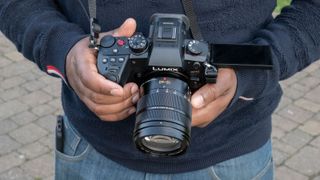
With every iteration of its Lumix GH series, Panasonic has been inching closer to creating the perfect filmmaker's mirrorless camera, and the Lumix GH6 makes a damn good case for having cracked it. We recently handed it over to a professional filmmaker for their take on it, and the verdict was that the GH6 offers: "a compelling set of features that simply can’t be rivaled at its price point."
With internal Apple ProRes 422 and ProRes 422 HQ, internal Cinema 4K 4:2:0 10-Bit, and many more class-leading options, the Lumix GH6 is simply a beast when it comes to video. It copes with its intense data demands by adding in a CFExpress Type B card slot, as well as a UHS-II SD card slot. Its design is also filmmaker-focused, with a vari-angle LCD screen, and physical controls including a dedicated audio management button.
Plus, it's a hybrid camera that's no slouch on stills! You don't put 75fps burst shooting in a camera if you don't think anyone's going to want to take pictures with it, after all. While the Lumix GH6 is primarily a filmmaker's camera, its impressive stills credentials mean it's one of the best buys around right now for content creators who can meet its price tag.
Read more: Panasonic Lumix GH6 review for more details
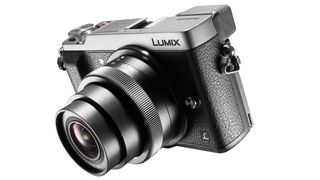
Incredible value for money, with or without its smart little 12-32mm kit zoom lens, the Panasonic Lumix GX80 / G85 shoehorns a host of high-tech features into its diminutive, compact-style build. These include 5-axis image stabilization, Light Speed AF, Post Focus and 4K ultra-high definition for both video and rapid-fire stills, as featured in Panasonic’s top-end cameras.
There’s also a high-res electronic viewfinder built into the back of the camera, along with a tilting touchscreen. If you want a camera that goes large on features and performance, but with a small build and price tag, this is an ideal choice. It's a great camera for travel, and its price makes it great for beginners, too. Even though this camera came out in 2016, it's still available and still competitive – so much so that one of our editors recently wrote a piece all about this impressive little camera and how it just keeps on going.
Read more: Panasonic Lumix GX80 / GX85 review
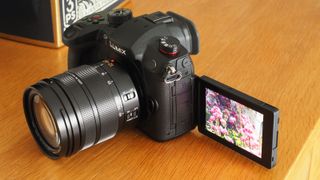
The original Panasonic Lumix GH5 was pretty widely regarded as one of the best consumer video cameras you could buy, so it makes sense that the Panasonic Lumix GH5 Mark II wouldn't mess too much with that formula. In fact, this is a very minor refresh all around, but the video features it does add make it definitely worth considering for those who produce video content, even with the newer Lumix GH6 also on the shelves.
The stabilization system provides up to 6.5EV steps of compensation, which is hugely handy (while not everyone likes the smaller Four-Thirds sensors, they are easier to stabilize). It also has live-streaming capabilities, and the video autofocus functions very well. Those who already own a Lumix GH5 or GH5S probably don't need to upgrade, but if you're looking for a new mirrorless filmmaking camera, this is a fantastic buy that's cheaper than the Lumix GH6. It's also no slouch with stills either!
Read more: Panasonic Lumix GH5 II review
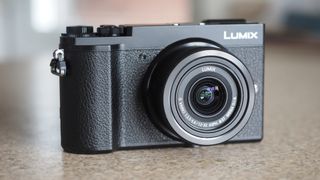
If you want a smaller and more portable camera than Panasonic's DSLR-style models, but you don’t want to compromise on features and technology, the GX9 is the answer! Its slender body features a high-res electronic viewfinder built into the back, rather than having a chunkier DSLR-style design. Good for shooting from any angle, the viewfinder and rear screen both have a tilt facility. And while small in build, the GX9 goes large on the inside, with a newly developed 20.3MP sensor that gives you the same resolution as the G90/G95 and Lumix G9, but in a much smaller camera. Other attractions include 5-axis sensor-shift stabilization and 4K capture for both video and rapid-fire photos. The GX9 is ideal for travel and for use with Panasonic's smaller lenses.
Read more: Panasonic GX9 review for more details
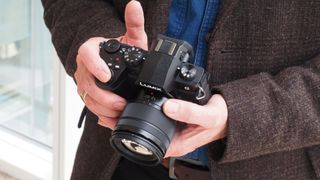
The Panasonic Lumix G90 (G95 in the US) is a great stills and video camera for enthusiasts and vloggers. The handling and control layout are great, and the autofocus feels very snappy indeed. The only issue is the price. It's a good camera for stills photographers, video, and vlogging, and Panasonic's underrated 4K Photo modes offer capabilities other cameras don't have.
The Lumix G90/G95 isn't cheap, however, though it does have Panasonic's V-Log mode as standard rather than a paid-for extra. It also has some strong competition from other Lumix models, so keep reading to see other Panasonic Lumix alternatives.
The Lumix G90/95 can be quite hard to find, especially outside the US. For whatever reason, it seems to have been pulled from shelves in territories like the UK even before the G80/85, which preceded it. However, if you can find one, the Lumix G90/G95 is a great buy.
Read more: Panasonic Lumix G90/G95 review for more details
Lumix S mirrorless
Announced in 2018 and on sale in the spring of 2019, the new full-frame mirrorless Lumix S models are designed for experts and professionals. We've left out the Lumix S1H because that's a specialized cinema that's a little too high-end for this guide, but there are still some solid cameras to tempt a broad swathe of photographers and videographers alike...
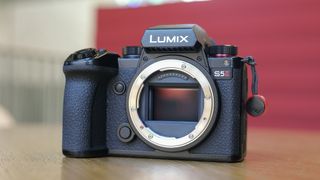

The Panasonic Lumix S5 II builds on the original Lumix S5 below, with a tough compact frame, class-leading 5-axis in-body image stabilization, and excellent color science. The most significant new addition is a Phase Hybrid autofocus system that combines PDAF with Contrast Detect AF to provide 779-area metering. This means it's better at detecting and tracking subjects, especially in low light and backlit scenarios.
The Lumix S5 II gives you truly unlimited 4K/60p 4:2:2 10-bit recording internally, S&Q 4K/60p (a high-speed 60fps) and FHD/180p, as well as up to 6K, full sensor readout video recording, making it a highly versatile camera for content creators.
Read our full Panasonic Lumix S5 II review for more details
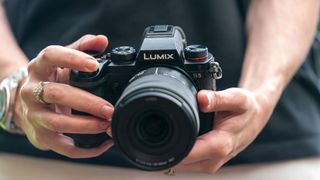
Despite its compact size, the Lumix S5 shares the impressive 24MP CMOS sensor housed in the Lumix S1, but with improved AF. It also has a tough weather-resistant body and delivers up to 6.5 stops of image stabilization with compatible lenses. Its standout features include class-leading dynamic range and 4K video recording, as well as 96MP high-resolution RAW+JPEG capture. We couldn't say enough good things about it in our review.
The Lumix S5 is smaller than the Lumix S1 and S1R before, and cheaper. It matches the Lumix S1 for stills and beats it for video, coming close to the capabilities of the far more expensive Lumix S1H. It's even more affordable now that it's been superseded by the Lumix S5 II, but it's still one of the bests Panasonic cameras.
Read more: Panasonic Lumix S5 review for more details
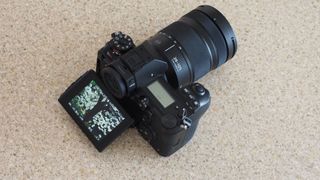
If you need top-quality stills photography, the Lumix S1R is worth the extra over the Lumix S1. It costs substantially more, but it has almost twice the resolution. Both are pretty big, hefty cameras, though, and the same goes for the L-mount lenses we’ve seen so far from Panasonic and Sigma (also part of the new L-mount alliance, along with Leica).
If you need to travel light and shoot stills and video equally, the smaller format Lumix GH5 or Lumix G9 models (above) might be a better choice. A firmware update in November 2019 has made this camera's XQD memory card slot compatible with the latest CFexpress memory cards, so Panasonic is ahead of the curve here.
As long as you don't mind a little bulk, the Lumix S1R is a high-resolution monster. It greatly impressed us with its resolving power in the testing labs, and it'll be interesting to see how the L-mount system develops to support it.
Read more: Panasonic Lumix S1R review for more details
Lumix compacts
Are you looking for a small but versatile travel camera for the whole family to use, a powerful supertelephoto bridge camera or an advanced compact camera for when you need to leave your main camera at home? Panasonic has all three...
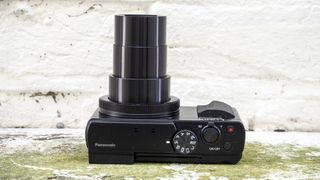
Sensibly priced but rich in features, the Panasonic Lumix ZS80 / TZ95 (it's ZS80 in North America, and the TZ95 in the UK and other territories) compact camera has a smaller sensor, but a 30x zoom lens with a more generous range than the 10x or 15x zooms in the pricier Lumix TZ100 and TZ200 models. The effective 24-720mm focal length range of the Leica lens takes you all the way from generously wide-angle coverage to extreme super-telephoto, while fully retracting into the camera for pocketable stowage.
And despite its super-slimline dimensions, there’s an electronic viewfinder as well as a tilting touchscreen around the back that can go through a full 180 degrees for those essential travel selfies! Even though the camera came out in 2019, we found in a recent review that its pocketable dimensions and generous zoom range still make it a winner for travel photography.
Read more: Panasonic Lumix ZS80/ TZ95 review for more details
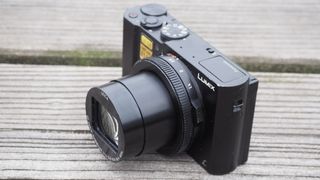
There are currently two ‘LX’ cameras in Panasonic’s premium range of compact cameras. Both are very attractive propositions; the LX100 Mark II combines a Micro Four Thirds format image sensor with a Leica zoom lens. For value, however, we prefer the Panasonic Lumix LX15. This camera has a smaller 1.0-type image sensor and a Leica Summilux zoom lens with an ‘effective’ 24-72mm focal length range, in full-frame terms. The camera is wonderfully compact yet packs some seriously powerful features, including Light Speed AF, hybrid stabilization, and 4K definition for both video and bursts of stills at 30fps.
Read more: Panasonic Lumix LX15 review
How we test Panasonic cameras
We test the best Panasonic cameras in real-world shooting scenarios and carefully controlled lab conditions. Our lab tests measure resolution, dynamic range, and signal-to-noise ratio. Resolution is measured using ISO resolution charts, dynamic range is calculated using DxO Analyzer test equipment and DxO Analyzer is also used for noise analysis across the camera's ISO range. We use these real-world testing and lab results to inform our comments in buying guides. Find out more about how we test and review on Digital Camera World.





